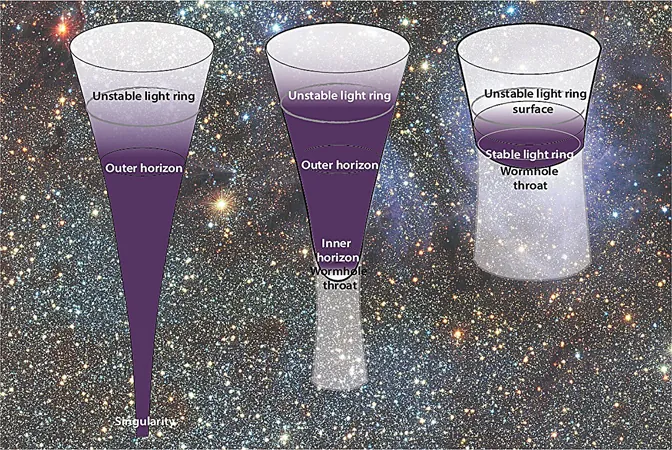
Revolutionary Black Hole Models Challenge Singularities with Quantum Physics
2025-05-06
Author: Wei
A Game Changer in Astrophysics
Ever since Albert Einstein introduced the concept of black holes through his theory of general relativity, scientists have grappled with a mysterious and troubling feature: the singularity at the center, a point where conventional physics crumbles. However, a groundbreaking new study from the Institute for Fundamental Physics of the Universe (IFPU) in Trieste challenges this notion by proposing alternative models that do away with singularities altogether.
New Insights from Quantum Effects
Published in the Journal of Cosmology and Astroparticle Physics, the paper reviews innovative black hole models that may incorporate quantum effects, potentially erasing the peculiarities associated with singularities. The research opens avenues for observational tests and could significantly aid in developing a cohesive theory of quantum gravity.
History in the Making
Stefano Liberati, one of the study's authors, notes the historical significance of this research, drawing parallels to the Latin phrase "Hic sunt leones," referring to uncharted territory—much like the enigmatic singularity at the heart of standard black holes. The journey began in 1915 when Einstein published his foundational paper, leading Karl Schwarzschild to discover solutions that underpinned modern black hole theory. However, as the understanding of these cosmic phenomena evolved, it became evident that singularities raise more questions than they answer.
The Ongoing Debate
Despite mounting evidence supporting the existence of black holes—from the first detection of gravitational waves in 2015 to stunning images of black hole shadows—questions surrounding singularities persist. The scientific community remains largely divided over the implications of these points of infinite gravity, which indicate a breakdown of the physical laws we rely on.
Exploring Non-Singular Options
At a recent IFPU workshop, experts collaborated to outline three distinct black hole models: the traditional black hole with singularity and event horizon, a regular black hole without singularity but with horizon, and a black hole mimicker that shares outside characteristics of a black hole without having either a singularity or event horizon.
The Path to New Discoveries
The paper discusses how these models might exist or transform into one another and suggests observational strategies to distinguish them from traditional black holes. Current observations have been remarkable yet limited to external features, leaving the true nature of singularities a tantalizing mystery.
A Bright Future for Quantum Gravity Research
As technology advances, researchers anticipate breakthroughs that could lead to improved observational tools focusing on these non-singular models. For example, enhanced imaging might reveal unexpected behaviors in light around these objects, while gravitational waves could hint at anomalies in spacetime geometry.
An Uncharted Era
Stefano Liberati emphasizes the potential of this research to bridge general relativity and quantum mechanics, paving the way for a new understanding of gravity. "What lies ahead for gravity research is truly exciting," he states, as we stand on the threshold of exploring vast, previously unexplored landscapes of the universe.





 Brasil (PT)
Brasil (PT)
 Canada (EN)
Canada (EN)
 Chile (ES)
Chile (ES)
 Česko (CS)
Česko (CS)
 대한민국 (KO)
대한민국 (KO)
 España (ES)
España (ES)
 France (FR)
France (FR)
 Hong Kong (EN)
Hong Kong (EN)
 Italia (IT)
Italia (IT)
 日本 (JA)
日本 (JA)
 Magyarország (HU)
Magyarország (HU)
 Norge (NO)
Norge (NO)
 Polska (PL)
Polska (PL)
 Schweiz (DE)
Schweiz (DE)
 Singapore (EN)
Singapore (EN)
 Sverige (SV)
Sverige (SV)
 Suomi (FI)
Suomi (FI)
 Türkiye (TR)
Türkiye (TR)
 الإمارات العربية المتحدة (AR)
الإمارات العربية المتحدة (AR)